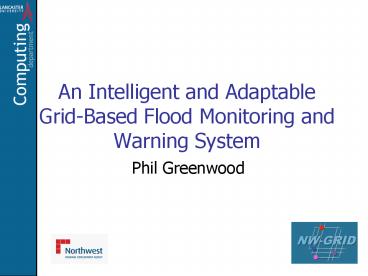An Intelligent and Adaptable GridBased Flood Monitoring and Warning System - PowerPoint PPT Presentation
1 / 21
Title:
An Intelligent and Adaptable GridBased Flood Monitoring and Warning System
Description:
An Intelligent and Adaptable Grid-Based Flood Monitoring and ... Compact Flash slot. Storage. 802.11b Networking. GPRS. GPIO Lines for sensor connectivity ... – PowerPoint PPT presentation
Number of Views:72
Avg rating:3.0/5.0
Title: An Intelligent and Adaptable GridBased Flood Monitoring and Warning System
1
An Intelligent and Adaptable Grid-Based Flood
Monitoring and Warning System
- Phil Greenwood
2
The Problem
- Flooding is becoming a more common occurrence
- Climate change
- Land use
- Cost of damage correlates with
- Rate of flow
- Depth of water
- Warning time given
- To cope with this problem initiatives taken to
- Improve flood defences
- Raise public awareness
- Improve flood warning systems
3
Traditional Approaches
- Deploy sensors at flood prone sites
- Collect data manually or transmitted using GSM
technology - Data then processed using spatial or point-based
prediction algorithms - The results from these algorithms can be used to
issue flood warnings
4
Limitations
- Rigid separation between on-site sensor network
and off-site computation Grid - Tends to be bottleneck
- The sensors used are computationally dumb
- They simply record and store/transmit data
- Data holds valuable information on how the
sensors should behave - No variation in the sensor behaviour possible
- Turn device off when un-interesting events
occurring - Increase frequency of measurements made
- No dissemination of warnings
5
Proposed Approach
- Increase local computational power of sensors
- Allow the local execution of flood prediction
algorithms i.e. light-weight Grid - Adaptation of the wireless sensor network
- Support a wider range of hardware
- Novel techniques for flood prediction and
analysis - Timely distribution of flood warnings
- Proactive and passive warnings
- SMS/Audio-Visual/Web
6
The GridStix Platform
- Consists of a variety of hardware and software
- Gumstix hardware platform
- Lancasters GridKit middleware platform
- Various networking technologies
- Flood prediction algorithms
7
Gumstix (1)
8
Gumstix (2)
- Specs
- 400Mhz Intel XScale processor
- 64Mb RAM
- 16Mb Flash Memory
- Variety of I/O Mechanism
- Standard Ethernet port
- Compact Flash slot
- Storage
- 802.11b Networking
- GPRS
- GPIO Lines for sensor connectivity
- On-board Bluetooth Radio
9
Power Consumption
- Significantly higher power consumption than
devices used in traditional sensor networks - Berkley Motes typically use 54mW
- Gumstix use 1W
- Can be powered using a combination of batteries
and solar panels - One 15cm2 solar panel output of 1.9W
- 6v 10AH battery
- Aggressive power management
10
GridKit (1)
- Provides key functionality to implement Grid
behaviour - Service Binding
- Resource Discovery
- Resource Management
- Security
- Based on the OpenCOM component model
- Rich support
- Stripped-down deployments
- Overlay support
- Used to implement networking service not provided
by the underlying network type
11
Overlay (1)
12
Overlay (2)
13
Supported Adaptations
- CPU Adaptation
- Throttle CPU frequency
- Overlay Adaptations
- Swap overlay components to alter topology
- Physical Network Adaptations
- Switch network types
14
Adaptation Scenario 1
- Changes in Criticality
- Need to conserve power in normal operating
conditions - Operate at lowest CPU frequency
- Poll sensor infrequently
- Potential Flooding Detected
- GridStix can increase CPU frequency to execute
prediction algorithms quicker - Data can also be collected more frequently to
improve the accuracy of the predictions
15
Adaptation Scenario 2
- Adapting to Node Failure
- Need to increase the robustness of network when
flooding is predicted - Do this without changing network type
- Switch overlay types
- Shortest path trees consume less power
- Fewest hop trees are more robust
16
Adaptation Scenario 2 cont.
Fewest Hops
Shortest Path
Root
Edge x
Edge x
Node B
Node C
Trigger Flooding predicted by a Gumstix.
Edge x
Edge x
Node D
Node E
Edge x
Node F
- Bluetooth continues to be used.
- Fewest Hop tree overlay applied to increase the
robustness of the tree.
- Bluetooth used by default due to lower power
requirements. - Shortest-Path tree overlay used due to its power
conservation characteristics.
17
Adaptation Scenario 3
- Node Submersion
- Likely that nodes will become submerged during
flooding - Want nodes to remain connected for as long as
possible - Switch network types when submersion is predicted
- Bluetooth -gt Wifi or Wifi -gt GPRS
- High power consumption and increased range
18
Adaptation Scenario 3 cont.
Fewest Hops
Fewest Hops
Trigger Submersion predicted by a Gumstix.
- Switch from Bluetooth to Wifi
- Same overlay type used.
- However, the different characteristics of Wifi
causes a new topology to be created.
19
Current Status
- Small test-bed of nodes currently deployed
- Three Gumstix Nodes
- Depth Sensors
- Image-based Flow Sensors
- Additional nodes are being added, to initial
deployment size of 13 nodes. - Performance of network hardware, solar panels and
other hardware is being tested in the field.
20
Future Work
- Development of a simulator to test deployment
approaches with past and predicted flood events. - Bringing in more highly embedded hardware running
the RUNES GridKit implementation. - Integration with Lancasters main NW Grid
Deployment.
21
Summary
- Proposes a more automatic and sophisticated
mechanism for collecting and processing flood
data - Convergence of Grid and Wireless Sensor Network
functionality - Uses this sophisticated mechanisms for performing
adaptations - Can customise the configuration and behaviour of
sensors to the current environmental conditions































